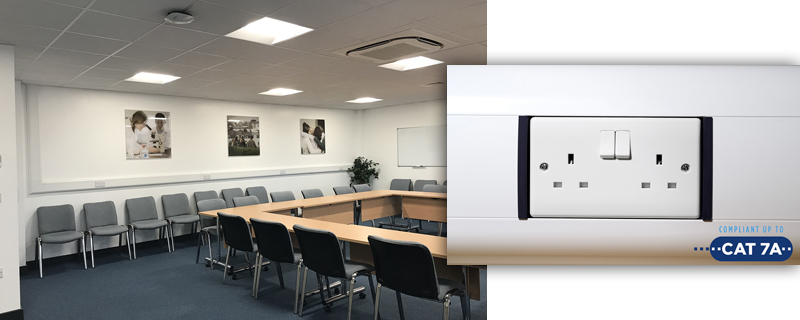Selecting cable trunking systems: what you need to know
Barry Roberts, National Specification Manager at Marshall-Tufflex explains what must be considered when specifying cable management systems for education settings to ensure they are fit for purpose, comply with the regulations, contribute to a safe and healthy environment and minimise the environmental impact of the new build or renovation projects.
The right cable management solution not only ensures the safety of staff and students but also protects the cables from accidental or intentional damage. When selecting trunking systems there are a range of factors that must be considered.
Regulations and Standards
For any specification or application, it is important to ensure that any system complies with the relevant regulations and standards. While the BS 7671:2018 Wiring Regulations provide specific guidance for installers, there are key requirements of which specifiers should be aware.
The regulations state that trunking systems should meet the IP4X requirements, meaning that objects 1mm in diameter or more cannot enter the trunking system. In addition, the BS EN 50085 standard states that trunking should be designed so the cover can only be removed by a tool or deliberate action.
The latest (18th) Edition of the Wiring Regulations also requires all cables to be adequately supported using non-combustible fixings to prevent premature collapse in the event of a fire. The heat of a fire can cause PVC-U and even some metal cable housings to fail. The result of this is falling and fallen cables that present a serious hazard to both those evacuating and the firefighters moving into and through the building. This means that the cables have to be fixed in place within the trunking using metal clips, such as the Marshall-Tufflex Firefly range, that have a melting point high enough to withstand the heat of a fire. This is a change from previous versions of the regulations that only required cables to be supported on escape routes.
Cable management systems must also comply with Approved Document M of the Building Regulations, which aims to ensure access to and use of the building for everyone. It is recommended that the accessory boxes and plates that house switches and sockets are specified in contrasting colours to make them more visible to those with visual impairments.
Cleaning and hygiene
Selecting the right trunking system can also help make school and college buildings easier to clean and more hygienic. One of the simplest steps is look for trunking that features a curved lid, or has a completely curved profile, such as our Sterling Curve or Odyssey trunking systems. This prevents items, including rubbish, being left on top of the trunking and makes cleaning easier.
There are also systems with anti-microbial properties, including several products from the Marshall-Tufflex range. When combined with a robust cleaning regime, these solutions can help protect those using the building from the risks of bacteria spreading. Incorporating silver ions within the material of the trunking can deliver ongoing antimicrobial protection that prevents 99.9% of harmful bacteria from surviving on its surface. This works by disrupting the key cell functions of bacteria and preventing them from reproducing – subsequently killing them due to their short lifespan. It is always recommended that specifiers look for products where the silver ions are integrated into the material during manufacturing, rather than added at post-production. This ensures a longer lasting protection and means that scratches or damage to the surface do not affect the anti-microbial performance.
Quality and durability
For educational facilities, cost is often a key consideration and although it can be tempting to choose more cost-effective cable management systems, the whole life cost should be factored in. Lower quality products are often more susceptible to wear and damage, meaning more maintenance work is required and the products have shorter lifespan before replacement. It can therefore be more cost effective across the lifespan of a building to select a higher-quality product that will stand the test of time.
Sustainability
Sustainability and environmental impact are now key factors on many education sector projects. Selecting cable management systems that are manufactured from recycled material is a simple way of reducing the use of virgin grade PVC-U and helping to prevent waste from being sent to landfill. For example, Marshall-Tufflex uses recycled PVC-U window frames within its manufacturing process. As these frames were designed to withstand external conditions, they are more than up to the demands of everyday interior use. In 2020, the proportion of recycled material in our products reached an average of 74%, with all white conduit and white mini and maxi trunking manufactured using 100% recycled material. In 2022, Marshall-Tufflex celebrates it’s 80th anniversary and in line with this we are aiming to achieve a figure of 80% usage of recycled product across our PVC-U range.
When selecting a cable management system for an educational building, it is important that it meets the needs of students and staff and is suitable for the demands of the environment. Choosing the right manufacturer, that can offer a range of solutions as well as support throughout the project, will help ensure the right products are specified.





Leave a Reply
Want to join the discussion?Feel free to contribute!